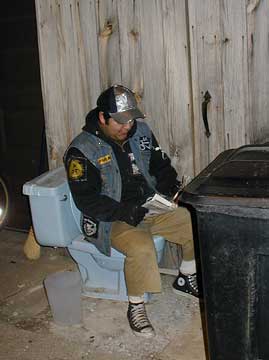Chicago's sewage treatment system, officially known as the Metropolitan Water Reclamation District, is a sprawling complex of astounding engineering achievements such as the reversal of the Chicago River across the continental divide, the immense floodwater control system known as Deep Tunnel, and the world's largest sewage treatment plant.
From the beginning, the Chicago River has been an important part of the city's sewage disposal. The river originally flowed into Lake Michigan. The North Branch meandered through low lands west of Waukegan, while the South Branch sprang from a swampy pond straddling the continental divide just 20 feet above Lake Michigan level. With such a low gradient, the river was lethargic and shallow. In times of little rain the waves of Lake Michigan pushed a sandbar across its mouth and the river simply seeped meekly through the beach sand into the lake, as the Dead River in Zion Illinois does to this day. In the beginning the citizens of Chicago dumped their food and human wastes in shallow pits or directly into the river which carried it away. Little Bubbly Creek, a tributary of the South Branch, received its name from the roiling brew of rotting hair, offal and greasy effluent produced the enormous Chicago Stockyards and dumped into the stream. At night, enterprising scavengers skimmed the fat from the surface and resold it to nearby rendering plants. In times of flood all these pollutants were carried down through the city into Lake Michigan, which is where Chicago drew its drinking water. Intake pipes were laid farther and farther out into the lake to avoid the tainted river water, up to 2 miles, but every disastrous summer storm proved even this was not far enough. So the city dug the Sanitary and Shipping Canal, an enormous trench cutting across the continental divide, and redirecting the flow of the South Branch of the Chicago River to the Des Plaines River and away from Lake Michigan. Chicago was free again to simply send its sewage downstream to Joliet, Peoria and St. Louis. Nowadays of course, we have a modern sewage treatment system. Our water comes from the three water intake cribs 2 miles offshore in Lake Michigan, is pumped to the water filtration plant next to Navy Pier. From there it flows through water mains of smaller and smaller size and out from individual faucets, showers and toilets, then back down the drain into increasingly larger and larger pipes until it ends up in one of seven sewage treatment plants in the system. If you flush your toilet north of Fullerton Avenue in Chicago, your waste will end up in the North Side sewage treatment plant in Skokie. Here the wastewater runs through a battery of treatment processes to purify it. First it is passed through screens to remove debris. Next it settles in large round outdoor tanks where rotating arms skim grease and fat from the surface while underwater arms wipe sludge that has stuck to the bottom of the tank. Then air and bacteria are pumped into the water to digest any organic matter. Solid material removed at this stage is aged for several years and sold as farm fertilizer. Finally the treated effluent is discharged into the North Shore Channel where it enters the river with over 90% of the pollution removed. Now does that sound inviting for a swim on a hot summer day? A major portion of the current of the North Branch comes from this discharged wastewater. You might think of the Chicago River as possessing two drainage basins, a natural watershed, where rainwater flows over land and into the river, and an artificial watershed (which may provide more volume) of pipes beginning several miles out in Lake Michigan, running across the city and far out into the suburbs, out of your sink, through you, and back down through pipes to the North Shore Channel. Despite the enormous capacity of the sewage treatment plants, the system is still easily overwhelmed in a summer storm. A sudden infusion of rainwater running off thousands of miles of pavement into storm sewer drains can cause the Water Reclamation District to pump raw sewage directly into the river in order to avoid overloading the system, and if the river rises too quickly, the sewage may be released into Lake Michigan. To avoid this the city began constructing an enormous 33-foot wide tunnel carved out of bedrock 300 feet below ground. The Deep Tunnel is a actually a network of tunnels following the course of the Chicago River, with separate systems under O'Hare and beneath the Calumet River. The idea is that excess wastewater would be dumped down into the Deep Tunnel, which flows toward the tunnel terminus (which can be seen from I-55 in Hockney). After the storm has passed, some of the largest pumps in the world send the water up to the world's largest sewage treatment plant in nearby Stickney, which is capable of treating 1400 million gallons of wastewater per day. If you are exploring along the river, you can easily see air shafts leading to the Deep Tunnel. A large round grating will give you an idea of the size of the tunnel 300 feet below, and you will easily smell the dank air from the water left in the bottom from the last storm flood. |
